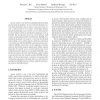Free Online Productivity Tools
i2Speak
i2Symbol
i2OCR
iTex2Img
iWeb2Print
iWeb2Shot
i2Type
iPdf2Split
iPdf2Merge
i2Bopomofo
i2Arabic
i2Style
i2Image
i2PDF
iLatex2Rtf
Sci2ools
COMPSAC
2007
IEEE
2007
IEEE
Conformance Checking of Access Control Policies Specified in XACML
Access control is one of the most fundamental and widely used security mechanisms. Access control mechanisms control which principals such as users or processes have access to which resources in a system. To facilitate managing and maintaining access control, access control policies are increasingly written in specification languages such as XACML. The specification of access control policies itself is often a challenging problem. Furthermore, XACML is intentionally designed to be generic: it provides the freedom in describing access control policies, which are well-known or invented ones. But the flexibility and expressiveness provided by XACML come at the cost of complexity, verbosity, and lack of desirable-property enforcement. Often common properties for specific access control policies may not be satisfied when these policies are specified in XACML, causing the discrepancy between what the policy authors intend to specify and what the actually specified XACML policies reflect. In...
Access Control | Access Control Mechanisms | Access Control Policies | COMPSAC 2007 | Software Engineering |
| Added | 14 Aug 2010 |
| Updated | 14 Aug 2010 |
| Type | Conference |
| Year | 2007 |
| Where | COMPSAC |
| Authors | Vincent C. Hu, Evan Martin, JeeHyun Hwang, Tao Xie |
Comments (0)

